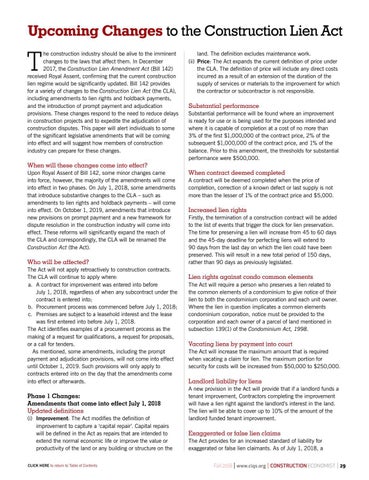Upcoming Changes to the Construction Lien Act
T
he construction industry should be alive to the imminent changes to the laws that affect them. In December 2017, the Construction Lien Amendment Act (Bill 142) received Royal Assent, confirming that the current construction lien regime would be significantly updated. Bill 142 provides for a variety of changes to the Construction Lien Act (the CLA), including amendments to lien rights and holdback payments, and the introduction of prompt payment and adjudication provisions. These changes respond to the need to reduce delays in construction projects and to expedite the adjudication of construction disputes. This paper will alert individuals to some of the significant legislative amendments that will be coming into effect and will suggest how members of construction industry can prepare for these changes.
land. The definition excludes maintenance work. (ii) Price: The Act expands the current definition of price under the CLA. The definition of price will include any direct costs incurred as a result of an extension of the duration of the supply of services or materials to the improvement for which the contractor or subcontractor is not responsible.
Substantial performance Substantial performance will be found where an improvement is ready for use or is being used for the purposes intended and where it is capable of completion at a cost of no more than 3% of the first $1,000,000 of the contract price, 2% of the subsequent $1,000,000 of the contract price, and 1% of the balance. Prior to this amendment, the thresholds for substantial performance were $500,000.
When will these changes come into effect? Upon Royal Assent of Bill 142, some minor changes came into force, however, the majority of the amendments will come into effect in two phases. On July 1, 2018, some amendments that introduce substantive changes to the CLA – such as amendments to lien rights and holdback payments – will come into effect. On October 1, 2019, amendments that introduce new provisions on prompt payment and a new framework for dispute resolution in the construction industry will come into effect. These reforms will significantly expand the reach of the CLA and correspondingly, the CLA will be renamed the Construction Act (the Act).
Who will be affected? The Act will not apply retroactively to construction contracts. The CLA will continue to apply where: a. A contract for improvement was entered into before July 1, 2018, regardless of when any subcontract under the contract is entered into; b. Procurement process was commenced before July 1, 2018; c. Premises are subject to a leasehold interest and the lease was first entered into before July 1, 2018. The Act identifies examples of a procurement process as the making of a request for qualifications, a request for proposals, or a call for tenders. As mentioned, some amendments, including the prompt payment and adjudication provisions, will not come into effect until October 1, 2019. Such provisions will only apply to contracts entered into on the day that the amendments come into effect or afterwards.
Phase 1 Changes: Amendments that come into effect July 1, 2018 Updated definitions (i) Improvement: The Act modifies the definition of improvement to capture a ‘capital repair’. Capital repairs will be defined in the Act as repairs that are intended to extend the normal economic life or improve the value or productivity of the land or any building or structure on the CLICK HERE to return to Table of Contents
When contract deemed completed A contract will be deemed completed when the price of completion, correction of a known defect or last supply is not more than the lesser of 1% of the contract price and $5,000.
Increased lien rights Firstly, the termination of a construction contract will be added to the list of events that trigger the clock for lien preservation. The time for preserving a lien will increase from 45 to 60 days and the 45-day deadline for perfecting liens will extend to 90 days from the last day on which the lien could have been preserved. This will result in a new total period of 150 days, rather than 90 days as previously legislated.
Lien rights against condo common elements The Act will require a person who preserves a lien related to the common elements of a condominium to give notice of their lien to both the condominium corporation and each unit owner. Where the lien in question implicates a common elements condominium corporation, notice must be provided to the corporation and each owner of a parcel of land mentioned in subsection 139(1) of the Condominium Act, 1998.
Vacating liens by payment into court The Act will increase the maximum amount that is required when vacating a claim for lien. The maximum portion for security for costs will be increased from $50,000 to $250,000.
Landlord liability for liens A new provision in the Act will provide that if a landlord funds a tenant improvement, Contractors completing the improvement will have a lien right against the landlord’s interest in the land. The lien will be able to cover up to 10% of the amount of the landlord funded tenant improvement.
Exaggerated or false lien claims The Act provides for an increased standard of liability for exaggerated or false lien claimants. As of July 1, 2018, a Fall 2018 | www.ciqs.org | CONSTRUCTION ECONOMIST | 29











